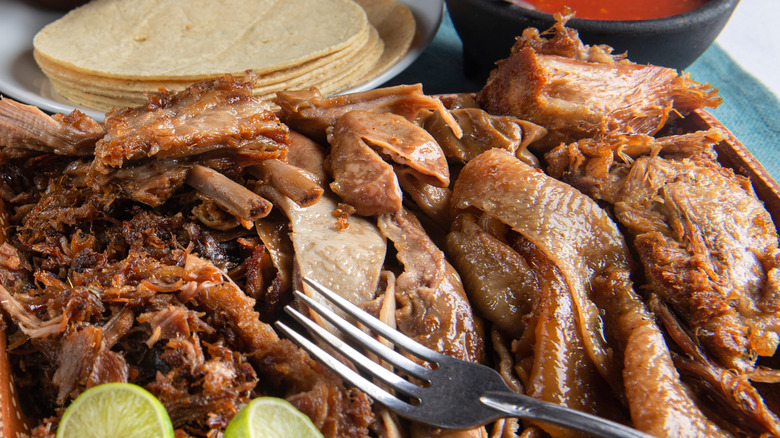Here's How You Can Save Dry Meat, According To Rachael Ray
It's something that happens to even the most skilled of home cooks. Perhaps you got distracted by a friend and you left your meat cooking for too long. Maybe your pan or oven were a bit too hot. Or it could be that the recipe you followed just wasn't very good. Whatever the reason, you're left with meat that's dry and overcooked — and you know it'll be tough, chewy and unenjoyable to eat.
But don't toss that meat just yet. Television personality and cookbook author Rachael Ray has a tip to help revive that overcooked meat and bring back some of the lost moisture, as the Rachael Ray Show reports. Now, you may need to be a bit flexible with your dish — her tips create a particular style of meat that may not be suited to every recipe. However, it's a way to ensure you don't waste a perfectly good cut of meat because of a cooking error. As a bonus, her tip doesn't include any rare ingredients — you likely have exactly what you need in your pantry.
Better yet, Ray's tip is more of a technique, and it can be used for virtually any type of meat, from turkey to steak. All you need to do is rehydrate that meat a bit with some flavorful juices — she suggests using either bone broth or some type of stock that complements your protein.
The 411 on her method
As the Rachael Ray Show explained, Ray advocates for slicing dry, overcooked meat against the grain and allowing it to bathe in broth or stock until the meat soaks up some of the juices. Kick Ash Basket suggests simmering the meat for a few minutes, not really cooking it further but rather just allowing that broth or stock to work its way into the meat. In addition, you may want to consider adding a bit more moisture by incorporating a sauce that pairs well with whatever meat you've overcooked.
While this is happening, pause to rethink your dish a bit — if you planned to serve the meat on its own, such as a seared steak or a roasted chicken breast, you won't be able to do that anymore. However, you can take that sliced meat and chop it further before incorporating it into a variety of dishes. Ray suggests adding it to pasta sauces, Mexican staples such as fajitas and quesadillas, or even leveling up your brunch game by adding the meat to potatoes to create a hash.
While Ray's hack is a handy tip to have when things go south, if you want to avoid overcooking meat in the future, you'll want to ensure you're checking the temperature of your proteins. Saving Dinner suggests using a digital probe thermometer to monitor when the required internal temperature is reached, so you'll know the end product will be perfectly cooked.

